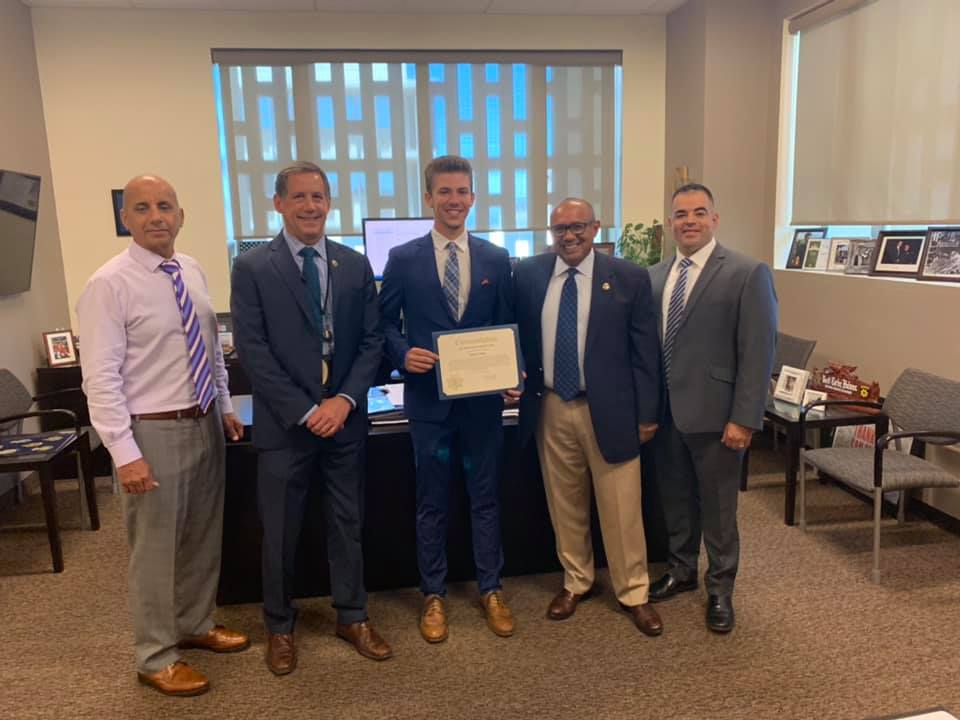Redwood City set to salsa
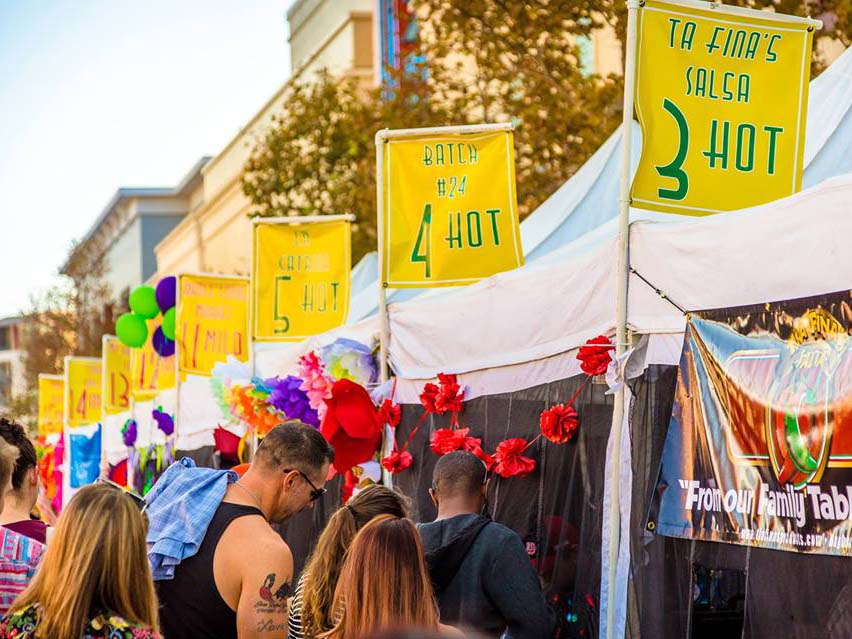

The 12th Annual Salsa Festival will encompass 11 blocks of downtown Redwood City from noon to 8 p.m. on Saturday.
The fun festival will feature salsa music, salsa dancing, salsa tasting and, yes, even a tequila tasting. The public tasting, a competition featuring both professional and amateur chefs, takes place from noon to 5 p.m., and organizers say you should come early to be sure to try them all.
Three stages (Courthouse Square Salsa Stage, Latin Jazz Stage and Reggae Stage) will feature Salsa, Latin Jazz, and Reggae music. The kids will enjoy hands-on art projects and a play area with bounce houses. City and community booths and local food vendors will also be on hand.
The festival takes place on Broadway between Middlefield and Hamilton and on the beautiful Theatre Way, all of which will be pedestrian-only.

Handley Rock, a rare geological formation in the Emerald Lake area of Redwood City, has cleaned up its act – with a little help from its friends.
Featuring a series of caves, the rock, the centerpiece of a privately owned park, was for decades the target of vandals and graffiti attacks. A 1992 letter to the editor from someone living near the huge boulder complained that the rock and its beckoning caves were “a 24-hour-a-day, 365-day-a-year hangout for largely underage drinkers, dopers, trashers and partiers.”
Arrests were few until 2017 when 10 vandals were identified and paid hundreds of dollars in fines. There were three incidents of swastikas being sprayed on the rock. Advances in technology get much of the credit for the arrests. As one online poster asked: “What part of ‘security cameras in use’ don’t people understand?”
Bill Vinci, current chair of the Handley Rock Park Association, doesn’t want to focus on the negative. “By and large the park is a treasured respite of open space,” he said. “It’s also deeply valued in the rock-climbing community.” For example, he pointed to the Bay Area Climbing Coalition whose members cleaned up the park in April, calling the work by volunteers “a real blessing.”
The sandstone monolith, about 50-feet tall at its highest point, is located on Handley Trail Way in the center of Emerald Hills. The only such rock in an urban area in San Mateo County, it resembles “skull rock,” the jungle home of the title character in “The Phantom” cartoon strip. Scientists say the caves were formed by water percolating through the sand and dissolving the cement holding the sand grains together.
The association, a private group of local residents and rock-climbing enthusiasts, operates the park. Not just rock climbers use the park. It also is a favorite of bike riders, walkers and picnickers. The area was so appealing, that 25 years ago owners Bev and Bill Oldfield wanted to preserve it as open space, which led to the formation of the association. Bill tried to donate it to the county but was rebuffed because of the small acreage involved. The association was thus born, thanks to help from the Access Fund, an open space group.
In a 1980 interview, Oldfield reported having problems with undesirable visitors. “Three years back a tough crowd got in there,” he told the Times Tribune newspaper. “I was hauling hundreds of bottle away. But with the sheriff’s help, I finally got the problem under control.”
Times Tribune reporter Janet Reinka wrote “rocks don’t change much but the people who visit them do.” She noted that the rock “was once a beehive of young children” who gradually had been replaced by mostly young adults. The lowest of the rock’s caves was known as “The Devil’s Cave,” which was big enough for three or four children to sit in and picnic or pretend to be Tom Sawyer. “For many who grew up in Redwood City, Handley Rock was one of the best secret places a child could find,” Reinka continued. “Former Sheriff Earl Whitmore and his brother Bob used to hike there from Birch Street to camp in the caves.”
So who was the Handley in Handley Rock? According to researchers at the history room of the Redwood City library, John Handley owned farming land in the area. He was also a deputy assessor. A son became a San Francisco police officer, while several girls in the family were teachers.
“The Handley family is identified with the early history of this city,” said a 1929 newspaper article about the retirement of Richard Handley from the police force. “The old timers will recall the boyhood of the retiring policeman and his sturdy father, who assisted in the upbuilding of Redwood City.” The article described Richard Handley as nearly seven feet tall and 275 pounds, a man with “squared shoulders, without an ounce of superfluous flesh, a perfect giant.” In hindsight, that sounds like the job qualifications for a guard who could scare away troublemakers at Handley Rock.
This story was originally published in the September print edition of Climate Magazine.
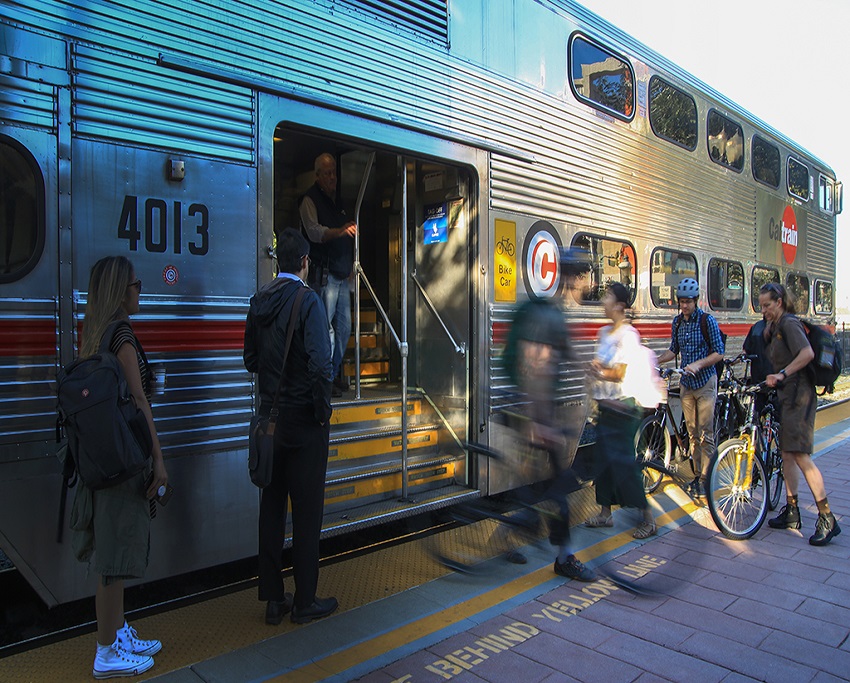
It’s 8:39 a.m. on a sunny Wednesday as Caltrain 329 pulls into Redwood City station, four minutes late. Every seat is filled, so 18 passengers stand in the last car and vestibule alone. A crowd of backpack-wearing commuters piles off the last Baby Bullet train of the morning.
Exiting passengers wend their way through a crowd of boarders and bicycles to tag off at Clipper terminals, which beep-beep like a Roadrunner cartoon. A young woman tries to board, only to be yelled at by the conductor. “Bikes on first please—you gotta learn.”
Some exiting passengers walk to the nearby Crossing 900 office building. Others head for the line of SamTrans buses or to Sequoia Station for coffee and bagels. It’s a vibrant urban scene that helps define a new downtown.
“Think of what’s a suburb. Back in the day it was a bedroom community,” says Adina Levin, who runs the Friends of Caltrain blog. “People commuted into the center city, San Francisco. Now we have the Redwood Cities that have many more jobs than homes and are in the heart of a major metropolitan area. It’s really not a suburb anymore, and that’s a significant transition.”
Redwood City was one of only two of the 10 busiest Caltrain stations that gained passengers in this year’s ridership survey. It’s the fifth largest station (after San Francisco, Palo Alto, San Jose Diridon, and Mountain View) with an average of 4,220 midweek passengers.
Surprisingly, after a decade of rapid growth, Caltrain’s average midweek ridership dropped 2.3 percent in this year’s survey, with 63,597 midweek passengers daily (since most commuters ride home too, the number of individuals carried is around half that). Overcrowding on peak-time trains was cited as one of the biggest factors in the decline, along with price increases for monthly passes.
The rail system thinks it can triple ridership by 2040. But with trains already so overcrowded at peak hours, how could that be possible?
Sebastian Petty, a Caltrain planner, has been working on something called the Long Range Service Vision–a plan to raise capacity. It consists of three alternatives—baseline, moderate, and high-growth.
By 2040, ridership would increase to 151,700 under the baseline, 177,200 under the moderate scenario, or 207,300 under high-growth.
Caltrain’s staff preferred option is the moderate scenario, while keeping the door open to further growth. Under that plan, there would be eight trains an hour at peak hours in each direction, or one every 7.5 minutes. Four would be local, the other four express.
Let’s say a passenger is traveling from Menlo Park to San Francisco. The local train would pick her up in Menlo and travel to Redwood City, then wait for the express to pull in. She would transfer to the express, which would pull out first. The local would follow–next stop, San Carlos.
Moving from the current irregular schedule to regular intervals would make it easier to connect with SamTrans buses and employer shuttles. The longest wait time at peak hours at major stations would be 22 minutes under the baseline scenario and 12 minutes in the moderate scenario.
In addition, four high-speed rail trains per hour in each direction would share the tracks, when and if that system is completed.
The first step is already under way—$2.3 billion in improvements, primarily for electrifying the route. Caltrain expects electrification to produce a 20 percent jump in ridership.
“Currently at peak hours we can run five trains per hour in each direction. That increases to six per hour when electrification is completed in 2022,” Petty said.
Caltrain is putting up poles alongside tracks to allow electric trains to run between San Francisco and San Jose. After the project is completed, about 75 percent of the trains will be electrified. Some diesel trains will still need to run, because Caltrain doesn’t own its tracks from San Jose to Gilroy and that part of the route will not be electrified.
After 2022, at least $16.3 billion in additional investments will still be needed, mostly by partners other than Caltrain.
In addition, at least $3.6 billion, and probably more, will be needed for items like additional cars, boarding improvements, and expanded storage and maintenance. The total bill under the moderate growth scenario? $25 billion, including $2.5 billion already invested.
Is all this government spending worth it? Advocates say the expansion isn’t just important to people who ride the train. It’s also needed to keep the road system from becoming even more gridlocked as the number of residents and jobs continues to grow.
“What happens to Caltrain affects any sort of transportation on the Peninsula,” said San Carlos Mayor Ron Collins, a member of the Joint Powers Board that runs the system, at a recent board meeting.
Currently, Caltrain carries the equivalent of four freeway lanes of people during peak hours. Ridership growth is expected to eliminate the need for between 4 and 8.5 additional lanes, Petty said.
The need for transportation will grow with the population of San Francisco, San Mateo and Santa Clara counties, which is expected to be 4,620,000 in 2040, up from 3,320,000 in 2010. Most of that gain will be in a corridor within two miles of Caltrain.
Expansion also is expected to have public health benefits. Sick days would be reduced since there would be more people walking or biking the recommended 30 minutes per day to get to stations.
The environment also would benefit from the reduction of emissions by diverting auto trips and eliminating the remaining diesel train service.
Property values are also expected to rise. An analysis performed for Caltrain shows that single-family home values are 7 percent higher within one mile of a high-frequency station like Redwood City. The benefit is only 3 percent near low-frequency stations. The additional value for condos is a bit less, 2 to 6 percent. Offices have the best return, with rents 20 percent higher within a half-mile of a train station.
Caltrain estimates its plans would raise property values $13-19 billion within a half-mile of a station, and $25-37 billion within one mile, by 2040.
The building boom around the Redwood City station makes the desirability clear.
Large projects are planned, like the Greystar Real Estate proposal for a six-block area on El Camino Real and Main Street near the train tracks. The site was formerly occupied by Towne Ford, Hopkins Acura, and other businesses. The plan calls for 291 apartments and 550,143 square feet of office space.
In August, a proposal by the Los Angeles-based real estate company Lowe Enterprises surfaced to redevelop Sequoia Station, including building housing and offices and revamping the core Safeway and CVS stores.
“There’s tons of transit-oriented development all along El Camino. When somebody’s proposing development within half-mile of a train station or good bus service, a lot of those folks will be able to take the train for some or all of their trips,” said Adrian Brandt, a lifelong area resident and transit advocate.
Some form of rail has been on the Peninsula since 1863. Redwood City and Palo Alto grew up around it and have substantial downtowns nearby. That’s unlike, say, Sunnyvale, which didn’t take shape until the post-World War II auto boom and isn’t oriented toward the train, Brandt said.
Why is Redwood City so important? Levin, who manages the Friends of Caltrain blog and frequently testifies at public hearings, says one reason is because of its central location between San Francisco and San Jose.
“Geometrically, they found from analysis they would need passing infrastructure in Redwood City because of in the middle of the line, a fast train could pass a slow train,” she said.
That would mean expanding the station to accommodate four tracks, with four platform faces, something that could be accomplished with two island platforms. The moderate growth scenario calls for a set of new passing tracks in Redwood City, while the high-growth scenario would extend them from Redwood City to Hayward Park.
There are already passing tracks at Bayshore and Lawrence, and more will be needed in higher-growth scenarios, including northern Santa Clara County.
Grade Separations: The California Public Utilities Commission requires that four-track rail lines are separated from roads, because of the danger. San Mateo County has 42 places where the tracks still cross streets at grade, snarling traffic and creating a safety hazard. Currently, 18 separations are being studied, Petty said.
Redwood City alone has six remaining grade crossings (Fifth Avenue, Woodside Road and Jefferson Avenue are already separated). Whipple Avenue, Brewster Avenue, and Broadway, north of the station, could require grade separations as part of the four-track expansion. Maple, Main, and Chestnut, south of the station, are less affected.
The city’s transportation plan calls for studying all six grade separations, with the northern three getting higher priority scores.
The biggest problem is at Whipple. According to a city report, the intersection has average daily traffic volume of 16,000 vehicles. It is regularly congested at commute times around the tracks and El Camino Real, and additional Caltrain service will make it even worse.
In a community survey, a Whipple grade separation was viewed as the second most desirable transportation project after improvements to the Woodside-Highway 101 interchange, with votes by 60 percent of the 100 respondents.
The city is spending $850,000 (mostly through a SamTrans grant) to study alternatives. A simple grade separation at Whipple would cost an estimated $150-300 million in 2009 dollars. An alternative that would fully elevate the railroad between Whipple and Maple, permanently closing Marshall Street, would cost roughly $500 million, while fully depressing the railroad between Whipple and Marshall would cost even more.
Dumbarton Corridor: Another reason why the Redwood City station is so vital is that it’s the likely connection point if cross-bay train service resumes on the Dumbarton Corridor. Train service began from Newark in 1910 and freight service ran until 1982, according to Carter Mau, Caltrain deputy general manager.
However, the old wooden trestle was severely damaged by a fire in 1998. Studies are under way for whether a completely new bridge would be needed.
With Facebook looking for new ways to bring employees to its Menlo Park campus near the rail line, “there appears to be a market for re-establishing service,” Mau said. Facebook and the infrastructure developer Plenary Group are currently conducting a feasibility study under an agreement with SamTrans.
Besides Redwood City and near Facebook, possible stops are at Marsh Road and in North Fair Oaks.
On the East Bay side, Dumbarton rail could be extended from Newark to Union City, potentially connecting with BART, Capitol Corridor from Sacramento, and ACE service over the Altamont Pass to the Central Valley.
Redwood City would need a larger station if Dumbarton rail becomes a reality, Brandt said. Because of limited space due to the big-box stores at Sequoia Station, one possibility would be to move it north, even past Broadway.
High-speed rail: With long delays, no clear source of adequate financing, and the Trump administration pulling back nearly $1 billion in funds, the future of high-speed rail between San Francisco and Los Angeles is in doubt.
Strong Towns blogger Daniel Herriges likened it to the unknown status of the cat in the uncertainty principle for radioactive emissions.
“Physicists studying politically-radioactive emissions from California have stumbled upon the strange case of Schrödinger’s Train. Is it alive? Is it dead? Who knows; let’s ask an observer.”
Caltrain’s plan forecasts two trains per hour in each direction to a completed segment in the Central Valley by 2029, and four per hour all the way to Los Angeles sometime after that. From San Jose, the route would run through Stockton, Merced, Fresno and Bakersfield.
Southern California Democrats in the Legislature have been talking about diverting funds from the Central Valley segment to rail projects in the more populous Los Angeles and Bay Area, which could mean more money for Caltrain’s own projects.
Still, Caltrain assumes eventually the system will be completed. “If high-speed rail is delayed, it could be 2050 instead of 2040,” Petty said.
Redwood City isn’t currently on the list of high-speed rail stations (the nearest would be Millbrae and San Jose), but Brandt is hopeful. “If high-speed rail ever gets here, there’s no reason why someday in the future Redwood City couldn’t be a station.”
San Francisco extension: One reason more commuters don’t take Caltrain is the location of the main San Francisco station at Fourth and King streets.
The booming area around the station is no longer a sketchy mess and is well-situated for sports fans, near the Giants’ Oracle Park and the Warriors’ new home at Chase Center. But it’s bad for most commuters, who face an eight-block walk or slow Muni ride to the heart of downtown and the bus and BART connections at Mission and Market streets.
Plans are under way to extend the line to the new Salesforce Transit Center south of Mission Street between Beale and Second streets, which ultimately will be the hub for 11 transit systems. When the extension is complete, expected in 2029, Caltrain sees its ridership jumping 25 percent.
The extension is currently in the early design phase. The total cost is $3.9 billion, but the project faces a significant funding gap that will have to be resolved through a mixture of federal, state, regional, local and private sources, according to the San Francisco County Transportation Authority.
At the other end of the line, a project to upgrade the San Jose Diridon Station (near SAP Center) is in the design and study phase. At some point, BART and high-speed rail will join Caltrain, buses, and light rail at the San Jose hub. Caltrain will fill the gap BART leaves between Millbrae and San Jose.
City’s Plan: RWCmoves, the city’s transportation plan, makes public transit an important part of its focus on reducing traffic congestion.
Its goals include eliminating traffic fatalities and severe injuries by 2030 and having non-driving modes account for 50 percent of all trips in the city by 2040.
According to the plan, Caltrain ridership in the city rose 73 percent between 2006 and 2015, from 1,840 to 3,240, the plan says. Only 5 percent of residents take public transit to work, but 20 percent are interested. Shuttle ridership is over 2,500 a month and over 10 percent of respondents say they’d be interested in taking shuttles.
Transit already accounts for 36 percent of the city’s downtown office commutes, compared to only 13 percent in suburban office parks, according to the plan. Three-quarters of the office park commuters drive, compared to less than half of those downtown.
“The point is that people in the downtown area drive significantly less,” Levin said. “Based on this information, the city has updated the plan for future development downtown such that only a third of the people in the buildings drive.”
The city’s separate Downtown Precise Plan calls for 2,500 market-rate housing units and 375 affordable-housing units in a 183-acre area, mostly within a quarter-mile of Caltrain and easily walkable.
Financing: Caltrain is owned by the Peninsula Corridor Joint Powers Authority, consisting of the transit agencies of San Francisco, San Mateo, and Santa Clara counties. It does not have a dedicated funding source, but receives about $30 million in annual subsidies from the counties.
The subsidy changes from year to year according to the financial condition of the agencies. Caltrain does not receive money from the sales tax measures that have been passed in the counties.
“Every year they’re always scrounging to keep the system going and improve service. It’s a bare-bones thing,” Brandt said. “They need a dedicated funding source such as every other system has.”
A 2017 study showed Caltrain had the highest farebox recovery ratio of any rail-based system in the country, at 70 percent, compared to 54 percent for New York’s Long Island Railroad. That’s partly because commuters move in both directions, reducing empty return trips.
Still, even under optimistic scenarios, the system will require subsidies.
In 2017, the Legislature passed S.B. 797, allowing the Joint Powers Board to levy a sales tax of one-eighth cent to finance Caltrain operations and capital expenses. The tax could only be imposed if the board placed it on the ballot and it was approved by two-thirds of voters in all three counties. It would bring in about $100 million a year.
The Joint Powers Board has been studying whether to put the tax on the ballot in either March or November 2020. A study the board commissioned by EMC Research showed 64 percent support among likely voters in the three counties, close to the two-thirds required.
“There is significant interest from the community in improving Caltrain, particularly as a way to relieve traffic congestion and speed travel along the Peninsula,” the study found. “While it’s not quite at the required two-thirds support today, with the right environment and effort a sales tax measure for Caltrain may be feasible in 2020.”
Support was at the two-thirds level in San Mateo and San Francisco counties, but only 61 percent in Santa Clara, showing a potential problem. “A lot of Santa Clara doesn’t know about Caltrain,” Brandt said.
Another possibility is a nine-county vote on a regional transportation sales tax, under what’s called the Faster Bay Area plan. Caltrain, BART and ferry service would all get money to improve service and connections.
“We’re talking with proponents and stakeholders on both fronts to help determine the best path forward for providing Caltrain with a dedicated funding source that will help implement our service vision,” said Caltrain public affairs specialist Dan Lieberman.
While maximum speed of trains is expected to improve from 79 mph to 110 mph, actual travel times won’t get all that much shorter, because of higher usage of the tracks and the continued existence of some two-track segments, limiting passing.
Under the baseline scenario, the ride from San Francisco to San Jose would take 69 to 73 minutes, about the same as today’s Baby Bullets. That would decrease to 61 minutes under the moderate scenario. The good news is that the longest ride from Redwood City is little more than half that.
Caltrain’s board of directors is hoping to adopt its service vision in October. More information is available at caltrain2040.org/ .
This story was originally published in the September print edition of Climate Magazine.
A pedestrian was struck and seriously injured by a police patrol vehicle that lost control on the wet roadway this morning in Redwood City while responding to a home invasion call, according to the Redwood City Police Department.
A K-9 patrol officer had been responding to a call about a possible home invasion in progress when the officer lost control of the vehicle as it was traveling southbound on El Camino Real, south of James Avenue, about 9:50 a.m. A man standing on the center median was struck as the patrol vehicle crossed it, police said.
The patrol vehicle then collided with two other vehicles in the northbound lanes before coming to rest on the east sidewalk, police said.
The pedestrian was transported to a local trauma center with injuries believed to be serious. The officer, a 12-year veteran, and the canine riding in the car did not appear to be injured but were set to be examined as a precaution.
The other drivers involved were examined the scene by paramedics and released.
The collision is being investigated by the California Highway Patrol, with the assistance of the CHP’s Major Accident Investigation Team (MAIT).

A ribbon-cutting ceremony on Wednesday will celebrate the opening San Mateo County’s new $64.5 million, 37,000 square foot Regional Operations Center (ROC) at the County Governement Center Campus in Redwood City, across from the County parking garage.
The ceremony will occur at 4 p.m. and will be followed by guided tours of the ROC.
The new center will house the Office of Emergency Services and 911 dispatchers who are currently located in the basement of the Eisenhower-era Hall of Justice. It will also house a secure data center and will feature space for county departments and partner agencies when the Emergency Operations Center is activated.
The ROC will serve as the “go-to location for response and recovery from earthquakes, wildfires, tsunamis, terrorist incidents and other major emergencies,” according to the County.
Supported by Measure K tax dollars, the ROC features 345 columns sunk 40 feet into the ground for seismic support. It is designed to operate for up to seven days without PG&E-provided power or city-provided water.
The building will also be certified LEED Silver by the U.S. Green Building Council.
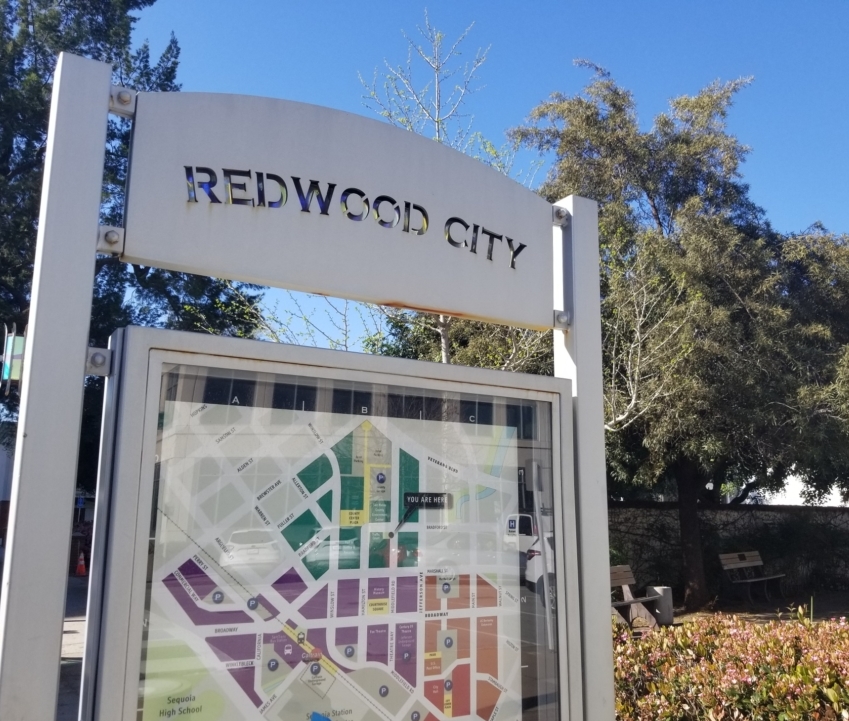
Redwood City is considering charging residents of neighborhoods where parking is hardest to find an annual fee in order to park in their area.
The proposal to establish a residential parking permit fee in high-demand areas was discussed at last week’s City Council meeting. The city recommends keeping the existing allowance of three permits per household in designated areas, but charging $60 per permit for the first two permits in the first year, $130 for the third, with annual renewals costing half the amount of the initial price. The proposal establishes a cost for visitor permits at $25 for 14 days and $4 for one day.
Currently, the city does not charge a fee as part of its Residential Permit Parking Program. The program was established 30 years ago near Sequoia High and Sequoia Hospital to discourage longterm parking by non-residents. Three years ago, parking scarcity led to an expansion of the program to areas near the south end of Broadway in Friendly Acres and near downtown in Stambaugh/Heller.
A continued lack of parking availability has prompted calls to expand the city’s residential permit parking program, according to city staff.
The proposed fees would only cover the cost of program’s administration, not the cost of its enforcement, according to city staff, which noted that the Redwood City Police Department was in the process of hiring two new parking enforcement officers for the program.
On Monday, Sept. 9, City Council approved amendments to the parking program, but did not decide whether to impose a fee. City staff is set to conduct public outreach in the coming months on how to amend the permit program, including whether to impose permit fees, before bringing the proposals back to council before the end of the year.
The fee proposal received mixed reviews during public comment and the Council discussion.
While residents say the Residential Permit Parking Program works, some opposed the concept of being charged to park in front of their homes.
Councilmembers expressed discomfort over the fee proposal, particularly Mayor Ian Bain.
“I have a philosophical problem with charging people to park on public streets, which, arguably, we are also already paying for with our taxes,” Bain said.
Bain and other councilmembers expressed concern over imposing yet another charge on residents struggling to afford staying in Redwood City, where the high demand for housing has increased residential costs.
Councilmember Janet Borgens, who lives in a residential permit area, said she’s more in support of increasing parking citation costs than imposing a fee.
“I do have concern because just the cost of hanging on in this community, to be able to stay here and live her and pay PG&E, rent and DMV fees that have increased, it’s expensive,” she said.
Councilmembers floated the idea of providing the first two of three permits alotted to households for free, and charging for the third. Another idea was to charge for permits on a sliding scale based upon income.
The parking problem in Redwood City is not going away, however, and the city will need to balance an expanding program with the need to fund it, Councilmember Diane Howard said.
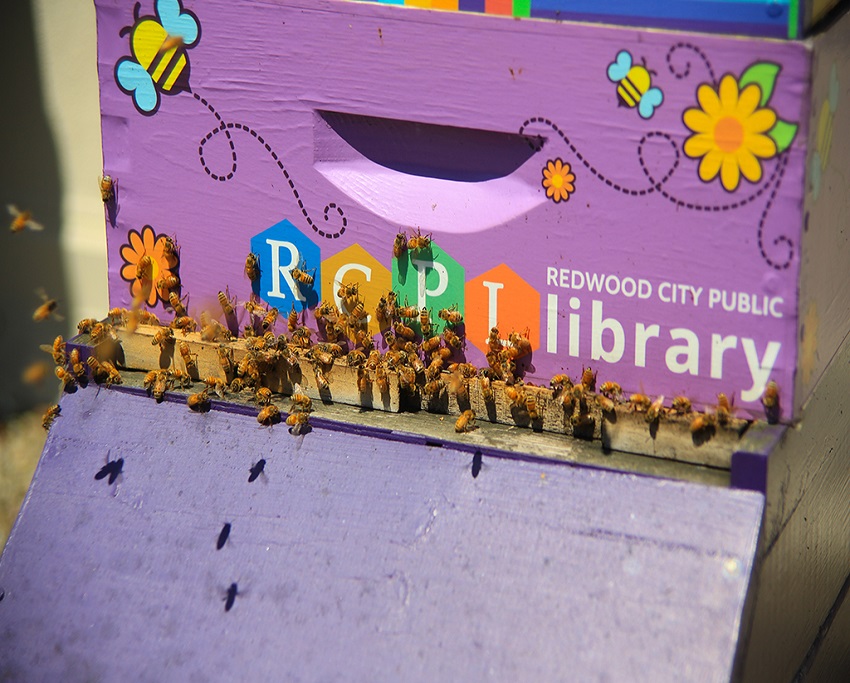
Honey…it’s kind of an unsung hero of the pantry, isn’t it? If you’re not a floral- or spice-note seeking connoisseur (which I cannot claim to be) it’s just kind of…there. A half-filled, slightly crystalized bear lurking at the back of the shelf waiting to be called into action.
But connoisseur or not, there is a new reason to get excited about honey: The Redwood City Public Library team is harvesting and selling sweet, golden nectar. The honey is sourced from the two cheerfully painted bee boxes that have been fixtures on the library rooftop since early 2018. Last year’s one and only harvest sold out within thirty minutes.
But fear not, because this year the harvest is much more plentiful. Library Director Derek Wolfrgam, who helped found the bee program with Parks, Recreation and Community Services Director Chris Beth, says that over the fall it’s expected that anywhere from 75 to 100 pounds of honey will be collected, plenty to keep the shelves stocked. The exact date this month that the honey will be available on the shelves of the Friends of the Library Bookstore (in the lobby of the library at 1044 Middlefield Road) was not available at the time of printing but will be announced on the Redwood City Public Library Bees Facebook page (https://www.facebook.com/rcplbees/).
Whenever it hits the shelves, this year’s bounty is a welcomed victory for the bee program: Shortly after last summer’s smaller harvest, the hives were struck by a common bee-killing mite. Sadly, there were no survivors.
“We lost all of them,” said Wolfgram, shaking his head. Though the initial setback was discouraging, he and the program’s partner, local beekeeper Kendal Sager, did not give up. Sager brought in new baby bees, and today the hives are estimated to be 110,000 bees-strong.
The strength of the beehives and all that honey-making offers a taste into the fascinating world of bees: The honey harvested in July and August is going to taste different from the honey harvested later in the fall. As Wolfgram explains it, this is because the first round of honey collected was made from springtime flowers, in particular, fennel. This will give the honey stronger, spicier notes. The later harvest will be made from summer flowers and is expected to have a sweeter, more floral taste.
A six-ounce jar costs $10. The proceeds go back into the library and are used to support children’s activities and educational programs like the Summer Learning Challenge. But it wouldn’t be a library program without an educational angle, would it? In addition to the hives on the rooftop, there’s a Bee Interpretive Center in the library’s children’s section. This is where the bee-curious, young and old, can learn more about the fascinating lives of bees, including their environmental importance and how to do the bees’ figure-eight “bee waggle” dance. There is even a solar-powered, livestream video of beehive activity.
“This is just such a unique and engaging way to learn. A way for us to create new experience that they wouldn’t expect at the public library,” Wolfgram said. He’s not the only one who thinks so. The program has caught the attention of state and national library associations. This fall, Wolfgram, Sager, and Library Supervisor Jenny Barnes have been invited to “spread the gospel of the bees” as Wolfgram puts it, at the California Library Association’s annual conference in October. The theme? A League of Extraordinary Librarians.
But the question for some (or many) may still remain: What does one do with honey, other than drizzle it over a scone or peanut butter toast (both delicious options, by the way)?
For those looking for something a little more exciting than a drizzle but still quick and easy, go for honey butter. Just mix ¾ cup of room-temperature butter with ¼ cup honey until completely combined. You’re of course welcome to play with ratios to make it more or less sweet. Alton Brown adds vanilla and cinnamon, but you don’t have to (I don’t). This is one of my favorite honey hacks because whether it be served at brunch, lunch or dinner, honey butter always takes cornbread muffins, buttermilk biscuits, and yes, scones, to new heights.
Alternatively, make this recipe for honey and mustard-glazed carrots. It comes from one of my favorite cookbooks — and is a reminder that honey plays nicely with the savory. Whether you go for the butter, the carrots, or just Google “honey cake” (seriously, there are so, so many recipes) you can’t go wrong. Bring some honeyed delight to your table this fall, and when your guests ask where your delicious, floral-noted nectar came from, make sure you send them to the library.
Glazed Carrots with Mustard and Honey
Vegetarian Cooking for Everyone, by Deborah Madison
These glazed carrots come together so quickly, they’re perfect for weekday meals and dinner parties alike. I think for a dinner party though I might not cut them as short and use rainbow-colored carrots — just to add some color and pizazz to the plate. Post carrot photoshoot, I put mine on a pile of spinach, sprinkled it all with a hearty dose of feta cheese, and it made for quite the lovely, late-night dinner (if I do say so myself).
1 ½ pounds carrots, scrubbed or peeled
1 tablespoon butter
1 tablespoon honey
2 teaspoons Dijon mustard
Salt and freshly milled pepper
Chopped parsley
Cut the carrots into 3-inch lengths; halve or quarter the thicker ends so they cook evenly. Steam or boil until tender.
In a medium skillet, melt the butter with the honey, then stir in the mustard and carrots and season with salt and plenty of pepper. Cook over medium heat for several minutes, until well-coated and bubbling, then toss with chopped parsley and serve.
This story was originally published in the September print edition of Climate Magazine.
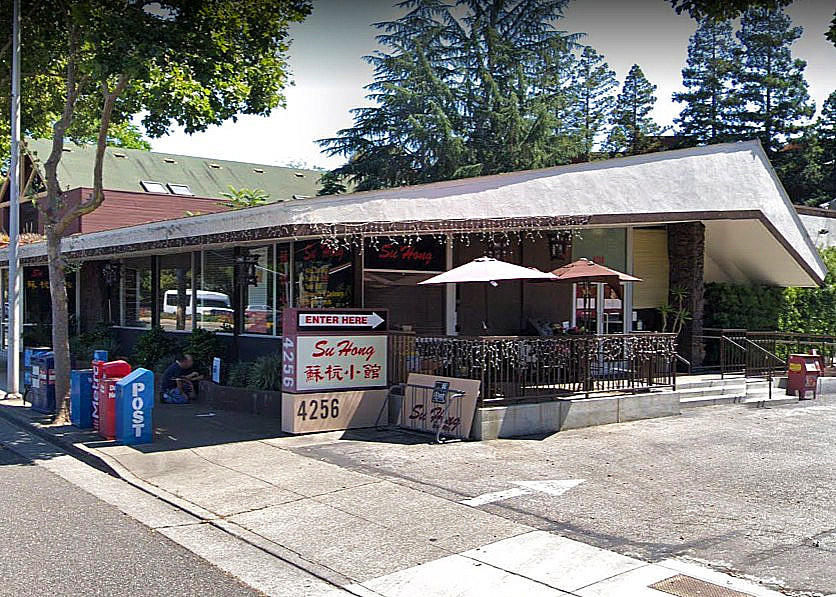
After a successful 42-year run, a popular Peninsula chef is set to close shop this month.
Su Hong in Palo Alto is set to officially close on Sept. 29, marking the end of an era for 70-year-old owner David King, according to the Palo Alto Weekly’s Peninsula Foodist.
King has sold the 3,300 square foot property at 4256 El Camino Real, which a developer is proposing to turn into a five-story, 100-room hotel.
It will be Su Hong’s last location to close. The restaurant had locations in Menlo Park that were sold by King’s ex-wife in 2015, according to Peninsula Foodist.
For more information about the reasons behind Su Hong’s closure, read the full Peninsula Foodist report here.
Photo: Google images, June 2017
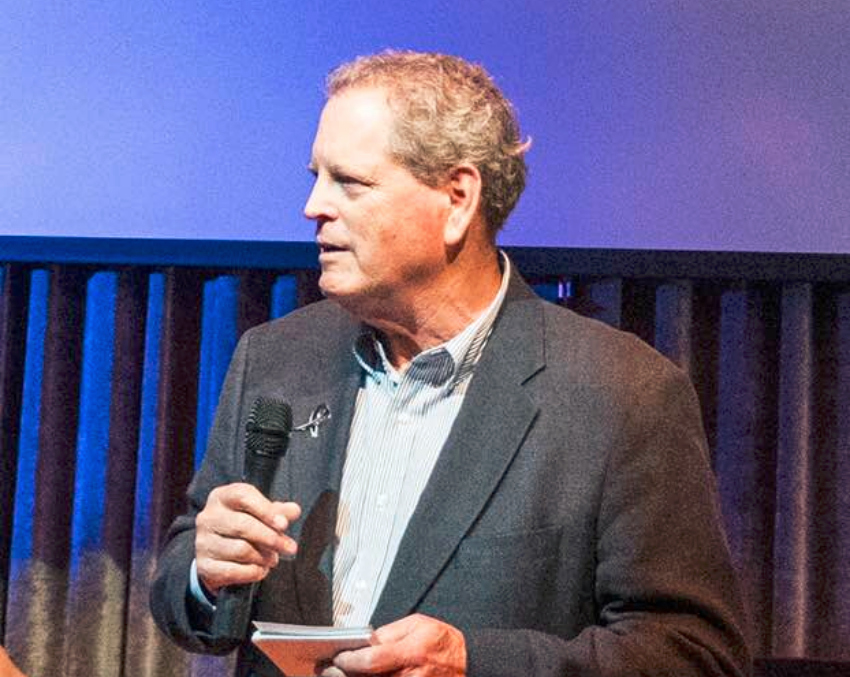
Veteran journalist and former Climate Magazine political columnist Mark Simon is now writing a weekly column for the San Mateo Daily Journal.
Simon made the announcement in his first column published today.
Simon was a veteran political reporter at the San Francisco Chronicle when he joined SamTrans in 2004 as a special assistant to the general manager and CEO. He worked his way up to Chief of Staff at SamTrans before retiring in 2017.
His journalism career was re-kindled in February 2018, when Climate Magazine invited him aboard as a political columnist. He became a leading voice in the community, crafting weekly pieces about local politics and issues and, on occasion, personal stories. He resigned his Climate column in July.
Climate Magazine Publisher Adam Alberti said the county is a better place when Simon is writing about it.
“Mark is an exceptional journalist. He’s about facts, fairness and getting to the truth,” Alberti said. “The Daily Journal and our community as a whole are very lucky to have his voice.”
In his first Daily Journal column, Simon referred to himself “a local news guy.”
“My roots as a journalist are grounded in local news,” he wrote. “Indeed, my interests always have been aligned with the Daily Journal’s. And those interests are local news, local politics, local life and local newspapers.”
In additional to his column, Simon also co-hosts The Game, a show on Peninsula TV about local politics and other topics, alongside Assemblymember Kevin Mullin.

It was a heroic action amid a tragedy.
San Mateo County Sheriff Carlos Bolanos awarded Junipero Serra High graduate Andrew Abbey for his bravery and lifesaving efforts at Poplar Beach in Half Moon Bay on Thursday, April 18.
That day, 18-year-old Naphtali Moimoi, a football star from Hayward, was boogie-boarding when he went underneath a wave and the board surfaced without him, according to the sheriff’s office.
Two of the teen’s friends rushed into the water but were unable to reach Moimoi, and one of those friends was also pulled into the rip current undertow, according to the report.
Abbey saw the distressed teen struggling and jumped into the water.
“Andrew maneuvered behind the teen, placed him in a lifesaving position and rescued him as Andrew brought him to shore,” according to the sheriff’s office. “Due to his quick actions, without regard for his own safety, Andrew was able to save the young man’s life.”
Tragically, Moimoi died.
Abbey, a Belmont native, is currently a freshman on the Men’s Track & Field team at Menlo College in Atherton.
Photo courtesy of the San Mateo County Sheriff’s Office
